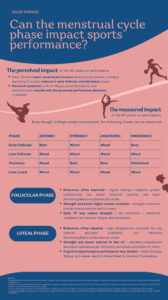Author: Ellen Zaradić
Keywords: female athlete, menstrual cycle, performance
Introduction
The menstrual cycle (MC) is a central feature of female physiology. Across the MC, concentrations of sex hormones such as estrogen and progesterone fluctuate, influencing physiological systems, including cardiovascular, respiratory, metabolic and neuromuscular parameters. Subsequently, it has been hypothesised that the MC phase could affect sports performance, yet research shows conflicting results (1). While many athletes report changes in performance across the cycle, objective measures often show limited or inconsistent effects (2). Understanding these dynamics is essential for supporting female athletes.
Thus, the aim of this blog is to summarize current evidence on the impact of the MC phase on physical performance.
- The Physiology of the Menstrual Cycle
A typical eumenorrheic MC lasts 21–35 days and is divided into two main phases: follicular (FP) and luteal (LP), with six sub-phases: early follicular (EF), late follicular (LF), ovulatory (O), early luteal (EL), mid luteal (ML), and late luteal (LL). The EF phase is characterized by low hormone levels, while the LF sees rising estrogen that triggers an LH surge and ovulation. The EL phase follows, with increasing progesterone and moderate estrogen. Hormone levels peak in the ML phase before declining in the LL phase, leading to menstruation and the start of a new cycle (3).
- Perceived Impact on Performance
In one review, more than half of athletes reported that their performance, along with strength, speed and power, was impaired during certain phases. Elite athletes were even more likely to notice performance impairments. Performance was perceived as most reduced in the EF and LL phases. Menstrual symptoms such as fatigue, mood disturbance, and menstrual pain coincide with the perceived performance detriment (2).
- Objectively Measured Impact on Performance
Research findings on the impact of MC phase on objectively measured performance, in contrast with research on the perceived impact, remain inconsistent. One review found 57% of analyzed studies reported no significant performance differences, while about 43% identified at least one outcome affected.3 Still, certain trends emerge:
Energy metabolism:
- improved endurance in FP might be due to greater carbohydrate utilization, caused by higher estrogen levels.4
- impaired endurance in LP along with the increased thermoregulatory and cardiovascular strain, might occur due to elevated progesterone promoting fat utilization, reducing glycogen availability. 4
Strength and Power Output:
- reduced in the LL phase due to decreased neuromuscular efficiency and increased perception of effort, potentially influenced by elevated progesterone levels (4).
Psychological and Cognitive Aspects:
- hormonal fluctuations influence mood, cognition, and injury risk, possibly impairing decision-making and response speed.4
In the following table, the performance output trends by phase are presented:
| Phase | Aerobic | Strength | Anaerobic | Endurance |
| Early Follicular | Best | Worst | Mixed | Best |
| Late Follicular | Mixed | Mixed | Worst | Mixed |
| Ovulatory | Mixed | Best | Best | Diminished |
| Late Luteal | Worst | Worst | Mixed | Mixed |
Table 1. Summary of trends across phases (3)
Recommendations
Individual variability in menstrual cycle characteristics, including differences in cycle length, hormonal profiles, and conditions like amenorrhea or polycystic ovary syndrome complicate universal recommendations. Even though most research focuses on the negative impact of the MC on performance, it has been found that adjusting training to the MC can improve performance outcomes and ultimately support athlete health (2). Still, further research is needed to develop these strategies.
Conclusion
While evidence is mixed, both subjective and objective data suggest that performance may fluctuate across the menstrual cycle. Individual responses vary, so a personalized approach should be taken based on each individual’s needs. Overall, more high-quality, standardized studies are needed to fully understand the impact of MC phases on performance.

References
- McNulty KL, Elliott-Sale KJ, Dolan E, Swinton PA, Ansdell P, Goodall S, et al. The Effects of Menstrual Cycle Phase on Exercise Performance in Eumenorrheic women: a Systematic Review and meta-analysis. Sports Medicine. 2020 Jul 13;50(10):1813–27.
- Oester C, Norris D, Scott D, Pedlar C, Bruinvels G, Lovell R. Inconsistencies in the perceived impact of the menstrual cycle on sports performance and in the prevalence of menstrual cycle symptoms: a scoping review of the literature. Journal of Science and Medicine in Sport. 2024 Mar 1;27(6).
- Carmichael MA, Thomson RL, Moran LJ, Wycherley TP. The Impact of Menstrual Cycle Phase on Athletes’ Performance: A Narrative Review. International Journal of Environmental Research and Public Health. 2021 Feb 9;18(4).
- Rosińska-Lewandoska D, Lewandowska D, Ufnal J, Podraza A, Strep D, Grabowska J, et al. The Impact of Menstrual Cycle Phases on Athletic Performance: A Comprehensive Review. Journal of Education Health and Sport. 2025 Feb 10;78:57659–9.